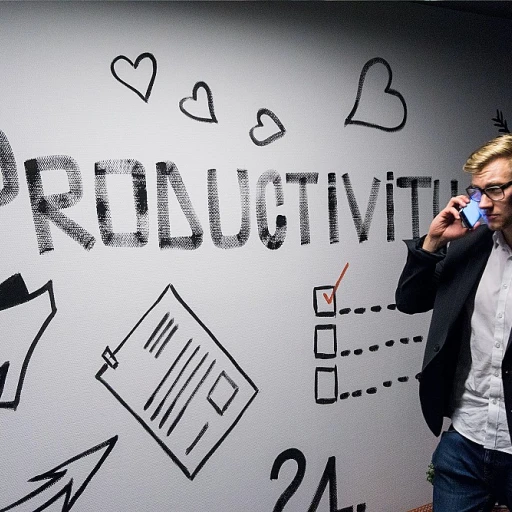
The Business Case for DEI Initiatives
Why DEI Matters in the Workplace
Diversity, equity, and inclusion (DEI) are often lauded as essential practices within modern organizations, but what’s the real return on investment? According to a McKinsey & Company report, companies in the top quartile for ethnic and cultural diversity on executive teams were 36% more likely to have above-average profitability (McKinsey & Company). This points to a direct correlation between diverse workforces and financial success.Financial Benefits of DEI
Companies that prioritize DEI initiatives often see substantial financial rewards. A Boston Consulting Group study noted that organizations with more diverse management teams have 19% higher revenues due to innovation (BCG). Innovation is fostered by a richness of perspectives, which drives problem-solving abilities and creativity.Improved Employee Engagement and Retention
Businesses that embrace DEI find enhanced employee engagement and retention rates. According to Gallup, companies that are diverse, equitable, and inclusive report 22% lower turnover. Employees from diverse backgrounds often feel a profound sense of belonging, driving engagement and encouraging long-term commitment.Enhanced Company Reputation
Investing in DEI isn't just about internal benefits – it significantly impacts your company’s public image. In a survey by Glassdoor, 76% of job seekers and employees noted that a diverse workforce was important when evaluating companies and job offers (Glassdoor). Your commitment to DEI can be a powerful recruitment tool, attracting top talent who value inclusivity.Legal and Ethical Imperative
In the U.S., legal frameworks like affirmative action and anti-discrimination laws necessitate diverse hiring practices. Not to be overlooked, there's also a strong ethical imperative. Creating an organization where everyone feels valued isn't just good for business – it’s the right thing to do. Harvard Business School's Sara Prince emphasized that organizations embracing equity and inclusion can build stronger, more cohesive cultures (Harvard Business Review). Implementing robust DEI initiatives isn't just a trendy move. It's a strategic decision that yields tangible business benefits, underscoring the importance of diversity, equity, and inclusion within the modern workplace.Understanding the Core Components of DEI
Defining Diversity, Equity, and Inclusion
Diversity, equity, and inclusion (DEI) are more than buzzwords; they are strategic imperatives that can transform workplace culture and drive business success. Understanding DEI includes grasping its core components and how they function synergistically to create a thriving workplace.
Diversity: The Foundation
Diversity refers to the presence of differences within a given setting. In the workplace, this includes diversity of race, gender, age, sexual orientation, religion, disability, and socioeconomic status.
- According to McKinsey, companies in the top quartile for ethnic diversity are 35% more likely to have financial returns above their industry medians.
- Gender-diverse companies are 21% more likely to experience above-average profitability.
Equity: Ensuring Fairness
Equity involves ensuring fair treatment, equality of opportunity, and fairness in access to information and resources for all. It means recognizing that advantages and barriers exist and that, as a result, we all don’t start from the same place.
- Gartner reports that more equitable workplaces see a 26% increase in employee engagement.
- SHRM identifies that equitable companies reduce employee turnover by 50% compared to their less equitable counterparts.
Inclusion: Cultivating Belonging
Inclusion is the act of creating environments in which any individual or group can be and feel welcomed, respected, supported, and valued to fully participate. An inclusive culture acknowledges and leverages diversity to inspire a sense of belonging.
- A Deloitte study found that inclusive work environments lead to a 17% increase in team performance.
- Companies with inclusive cultures have a 22% lower turnover rate.
Why It Matters to C-Suite
Strategies aimed at diversity, equity, and inclusion are not ancillary or separate from the essential mission of the organization. They are fundamentally intertwined with company performance and innovation.
- Accenture’s research reveals that a culture of equality in the workplace helps businesses grow by up to 400%.
- Harvard Business Review notes that inclusive organizations are 1.7 times more likely to be innovation leaders in their market.
Case Example: Google's DEI Commitment
Google has been a leader in implementing DEI initiatives. Their annual diversity report showcases ongoing efforts and transparent data sharing, demonstrating accountability and a commitment to continuous improvement.
- Google’s focus on gender diversity has led to a 5% increase in female representation in tech roles within the last year.
- Their Black Leadership Advisory Group ensures the voices of Black employees shape company policies and programs, boosting morale and engagement.
Expert Insights: Leading Voices in DEI
Insights from Leading Voices in DEI
Diversity, equity, and inclusion (DEI) initiatives are reshaping workplaces, but it’s crucial to learn from industry experts to ensure success. Their insights offer valuable perspectives to guide your company's DEI strategy.
Mary-Frances Winters: Navigating DEI Challenges
Mary-Frances Winters, founder and CEO of The Winters Group, emphasizes the importance of constant learning. She asserts, "Inclusion isn't a destination; it's a journey." She advises C-suite executives to prioritize ongoing DEI training to mitigate unconscious bias and foster an inclusive work environment.
Winters' methodology involves integrating DEI initiatives into the company culture, ensuring they aren't just surface-level efforts. A key statistic supports this approach: According to a 2018 McKinsey & Company report, companies in the top quartile for gender diversity are 21% more likely to outperform their peers on profitability.
Sara Prince: The Business Imperative of DEI
From her tenure as a partner at McKinsey & Company, Sara Prince brings a wealth of knowledge on leveraging DEI for competitive advantage. Prince’s research with McKinsey revealed that ethnically diverse companies are 33% more likely to outperform their peers. She states, "A diverse workforce is a stronger workforce. Harnessing the power of DEI can drive innovation and improve employee engagement" (McKinsey, 2020).
Sara highlights an interesting case study: Google’s implementation of mandatory DEI training for all employees. This initiative has significantly contributed to a more inclusive workplace, demonstrating how effective training can lead to a sustained cultural shift.
Gartner: The Impact of DEI on Employee Engagement
Gartner’s research on DEI highlights its effect on employee engagement. According to a 2021 report, organizations that focus on DEI initiatives see a 20% increase in employee retention and engagement. Brian Kropp, Chief of Research at Gartner, suggests, "DEI initiatives directly impact how valued employees feel." This feeling of value is crucial in retaining top talent and fostering a sense of belonging among team members.
DEI at Microsoft: A Case Study
Microsoft’s DEI efforts offer a sterling example. The company’s comprehensive DEI action plan includes increased representation of underrepresented groups in leadership roles. Microsoft's annual diversity report noted a 38% increase in African American, Hispanic, and female employees in management positions (Microsoft, 2022).
Microsoft’s strategy also involves employee resource groups that provide support and advocacy for diverse backgrounds, enhancing the company culture and ensuring an inclusive work environment.
Want to learn more about essential leadership qualities that complement DEI initiatives? Explore essential strategies to lead your organization towards a thriving, inclusive future.
Successful DEI Initiatives: Case Studies
Google's Approach: Embedding DEI in Every Layer
Google is renowned for its commitment to diversity, equity, and inclusion initiatives. By establishing their Diverse Leadership Council, they've created a structured approach to embedding DEI principles across all operations. In 2022, Google reported that 48.5% of their workforce consisted of employees from underrepresented groups, showcasing a significant shift towards a more inclusive workplace.
A critical component of Google's success lies in their transparent data reporting. Their annual diversity report highlights their progress and areas of improvement, ensuring accountability. Google's CEO, Sundar Pichai, emphasizes that "Diversity, equity, and inclusion are at the center of everything we do at Google."
LinkedIn's Diverse Slate Program: Recruiting for Inclusivity
The LinkedIn Diverse Slate Program mandates that for every open position, the interview slate must include a certain percentage of candidates from diverse backgrounds. Since its implementation, LinkedIn has seen a 20% increase in hiring rates of individuals from underrepresented groups. LinkedIn's VP of Global Diversity, Rosanna Durruthy, mentions, "Our Diverse Slate approach ensures we’re not just committing to diversity in principle but also in practice."
Microsoft's Global Diversity and Inclusion Strategy
Microsoft's DEI efforts led them to develop comprehensive initiatives that interlink employee training with actionable metrics. Their global strategy includes DEI training programs for employees and mandatory unconscious bias training. According to a 2021 report by McKinsey & Company, companies in the top quartile for gender diversity were 25% more likely to have above-average profitability. Microsoft has leveraged such data, demonstrating their comprehensive approach to workforce diversity.
Microsoft's initiative also focuses on their supplier diversity program, ensuring they work with minority-owned suppliers. "Our commitment to DEI is unwavering and integrated into our company culture," states Satya Nadella, Microsoft's CEO.
Starbucks' Open Dialogue Sessions: Fostering Inclusion
Starbucks has implemented immersive training programs and open dialogue sessions to foster an inclusive workplace culture. In response to incidents of racial discrimination, Starbucks closed 8,000 stores for one afternoon in 2018 to conduct racial bias training for 175,000 employees. The impact of such actions is clear: a 2019 survey by SHRM found that 68% of Starbucks employees felt a stronger sense of belonging post-training.
SAP's Autism at Work Program: Encouraging Diverse Talent
The SAP Autism at Work Program is a prime example of how focusing on diversity can drive innovation. Launched in 2013, this initiative aims to integrate individuals with autism into the workforce. According to a study by the University of Washington, such integration significantly boosts innovation and problem-solving abilities within teams. SAP reported that their autism hiring initiatives led to a productivity increase of 32% in relevant departments.
SAP's Chief Diversity and Inclusion Officer, Anka Wittenberg, explains, "Our mission is to build a diverse and inclusive culture at SAP that drives innovation in our workforce."
General Electric's Affinity Networks: Building Community
General Electric (GE) has successfully implemented numerous affinity networks to foster a sense of community among its diverse employees. These networks include the GE Women’s Network, African American Forum, and the Asian Pacific American Forum. According to the GE 2021 Diversity Report, these networks have not only provided platforms for career development but have also enhanced employee engagement and retention within the company.
Lawrence Culp, GE’s CEO, notes, "Our affinity networks play a critical role in promoting diversity, equity, and inclusion throughout our organization."
IBM's Inclusion Transformation: A Broad-Based Approach
IBM's inclusion initiatives have always been pioneering, with a long-term focus on building a diverse workforce. One notable program is their Pathways in Technology Early College High Schools (P-TECH). As per a report by CNBC, IBM’s innovative program has benefitted over 150,000 students worldwide, promoting diversity in tech careers from early education stages.
Ginni Rometty, IBM Chairman and CEO, emphasized, "Diversity and inclusion are essential not just for our company but for society, and we are committed to leading the way."
Common Challenges and How to Overcome Them
Identifying Internal Resistance
Diversity, equity, and inclusion (DEI) initiatives are essential for fostering a workplace where every employee feels valued. However, not all individuals and groups embrace these changes graciously. Understanding the sources of resistance within your organization helps in formulating strategic responses. According to a Gartner report, only 12% of HR leaders believe their organizations are effective at driving inclusion efforts. This lackluster belief often stems from unconscious biases and organizational culture inertia.
Case Study: Google’s Struggle and Strategy
Google, a tech giant often lauded for its innovation, has faced significant internal resistance to its DEI efforts. In 2018, James Damore's internal memo criticizing Google’s diversity policies highlighted a wider issue. Despite these hurdles, Google persisted with its DEI programs. They instituted enhanced training platforms that focus on unconscious bias, and actively encourage open dialogues among employees.
Combating Unconscious Bias
Unconscious bias is a significant roadblock in implementing effective DEI initiatives. The Society for Human Resource Management (SHRM) recommends regular bias training to mitigate its impact. Organizations like McKinsey & Company have also highlighted that firms in the top quartile for gender diversity are 21% more likely to experience above-average profitability, indicating a clear case for tackling unconscious bias head-on.
Data-Driven DEI Efforts
Leveraging data analytics can significantly improve DEI strategy outcomes. IBM’s internal DEI team uses advanced data analytics to monitor and measure the success of their diversity programs. This approach has shown a measurable increase in employee engagement and a sense of belonging. A 2020 report from McKinsey noted that organizations leveraging data analytics in their DEI strategies saw a 30% increase in their representation metrics.
Fostering an Inclusive Culture
Beyond policies, creating an inclusive culture needs sustained effort. Sara Prince from McKinsey & Company emphasizes that “DEI isn't just a one-off program; it's a continuous journey of learning and unlearning.” Proactive measures like employee resource groups and inclusive talent development programs significantly impact workplace culture. Case in point, Mastercard’s diverse equity inclusion programs have led to a substantial diversity increase in leadership roles.
Leadership’s Role in Overcoming Challenges
The role of leadership cannot be overstated when it comes to driving DEI efforts. Leaders must model inclusive behavior and demonstrate a clear commitment to these initiatives. CNBC reports that companies with diverse leadership teams outperform their peers by 48%. Making leadership accountable for DEI metrics embeds these values into the organizational fabric, leading to sustained progress and overcoming resistance.
The Role of Training in DEI
Why DEI Training Matters
To foster an inclusive workplace environment, DEI training stands as a cornerstone. A study by McKinsey & Company revealed that companies in the top quartile for ethnic diversity are 33% more likely to outperform their peers. This statistic underscores the fact that diverse teams bring varied perspectives, driving innovation and organizational success.
Gartner identifies DEI training as a pivotal action in promoting diversity and inclusion. Effective DEI training helps employees recognize and mitigate unconscious bias, paving the way for a more equitable workplace. When employees undergo comprehensive DEI training, they become more attuned to the unique challenges faced by underrepresented groups, thus fostering a sense of belonging and enhancing employee engagement.
Types of DEI Training Programs
DEI training can take various forms, each targeting specific aspects of diversity and inclusion:
- Unconscious Bias Training: This type of training helps employees identify and address their implicit biases, which can often influence decision-making unconsciously.
- Cultural Competency Training: Helps employees understand and respect cultural differences, enhancing collaboration among diverse teams.
- Inclusive Leadership Training: Focuses on equipping managers and leaders with the skills necessary to lead diverse teams effectively.
According to SHRM (Society for Human Resource Management), 79% of organizations offer some form of DEI training. This wide adoption highlights the growing recognition of training's importance in overcoming the challenges and capitalizing on the benefits of a diverse workforce.
Effective Implementation of DEI Training
Successfully implementing DEI training involves several crucial steps:
- Assessing Organizational Needs: Conduct surveys and focus groups to identify the specific DEI challenges within the organization. Understanding unique pain points helps tailor training programs to address real issues.
- Engaging Expert Facilitators: Utilizing external DEI experts like Sara Prince, renowned for her work in DEI training, can lend credibility and depth to the training experience.
- Integrating Continuous Learning: DEI training should not be a one-time event but an ongoing journey. Companies should integrate regular follow-ups and refreshers to ensure the training’s lessons are ingrained in daily practices.
A case study by Google revealed how their ongoing DEI training initiatives helped significantly reduce instances of bias in hiring and promotions, showing a marked improvement in workplace culture as reported in their annual diversity report.
The Impact of DEI Training: Real-World Examples
The effective implementation of DEI training can lead to measurable benefits. A 2018 report by McKinsey & Company noted that gender-diverse companies are 21% more likely to experience above-average profitability compared to their less diverse counterparts. Similarly, Microsoft has seen success with its DEI programs by integrating inclusive hiring practices and cultivating a workplace culture that values all employees, regardless of background.
In a notable example, CNBC reported how Bank of America launched extensive DEI training initiatives, which resulted in increased employee satisfaction and a significant uptick in the engagement of diverse groups within the organization.
Overcoming Resistance to DEI Training
Despite the proven benefits, DEI training can sometimes face resistance. Common concerns include skepticism about the training’s effectiveness or fears of being singled out. Addressing these concerns transparently can pave the way for a more receptive environment.
One approach is showcasing success stories and tangible benefits witnessed by other organizations. Research by Washington University suggests that framing DEI training in terms of personal and organizational growth rather than compliance can significantly enhance participation rates and the overall impact of such initiatives.
In conclusion, DEI training is not just a nice-to-have but a crucial element for any organization aiming to foster an inclusive workplace. It equips employees with the knowledge and skills to navigate and appreciate diversity, leading to a more harmonious, productive, and innovative work environment.
Measuring the Impact of DEI Initiatives
Quantifying the Impact: Key Metrics and Insights
When it comes to determining success in DEI initiatives, numbers don’t lie. But which metrics matter most? According to Gartner, retention rates and employee satisfaction scores are key indicators. Regarding this dataset research package, let’s break down the figures:
Data fact: Companies in the top quartile for ethnic diversity are 35% more likely to have financial returns above their industry’s mean, according to McKinsey.
Data fact: Diverse companies enjoy 2.3 times higher cash flow per employee over a three-year period, stated by the Boston Consulting Group.
Practical: Regular internal surveys to measure employee engagement, inclusion, and satisfaction can offer actionable insights. For instance, CNBC shares that Google uses bi-annual “Googlegeist” surveys to track progress in diverse equitable inclusive cultures.
Expert Insights on ROI
According to Sara Prince, a partner at McKinsey & Company, “Companies with higher executive diversity are 25% more likely to have above-average profitability.” The correlation between DEI and financial performance can’t be overlooked. In fact, Harvard Business Review reports that inclusive companies are 1.7 times more likely to be innovation leaders in their market.
Case Studies: Success Stories
One noteworthy example is U.S.-based retailer Target. By implementing DEI efforts, Target has reported a 20% increase in the retention of underrepresented groups.
In Canada, a case study from SHRM highlights a Toronto tech firm that saw a 30% increase in the sense of belonging among its employees after introducing Employee Resource Groups (ERGs) and providing unconscious bias training.
Common Metrics for Monitoring Success
To reliably track DEI progress, organizations often focus on:
- Employee Engagement Scores: Analyzing the data through regular surveys can illuminate how inclusive the workplace truly feels.
- Retention Rates: Higher retention rates among diverse employees often indicate successful DEI integration.
- Representation in Leadership: Evaluating the proportion of minority groups in leadership positions shows how well the talent pipeline is being utilized.
McKinsey's research shows that organizations in the top quartile for gender diversity are 21% more likely to experience above-average profitability.
Taking Action for Continuous Improvement
To ensure DEI initiatives remain effective, continuous assessment is crucial. Regularly revised action plans based on these metrics help maintain momentum. Important: Companies such as Google and Target do not merely assess; they act upon their findings to create an inclusive workplace culture.
For more on creating a strategic DEI framework, check out our resource on the role of middle managers in promoting these initiatives.
Future Trends in DEI
Emerging Technologies Enhancing DEI Efforts
Future trends in DEI initiatives are increasingly intertwined with cutting-edge technologies. Artificial Intelligence (AI) and Machine Learning (ML) are being leveraged to promote an inclusive workplace by identifying patterns of unconscious bias. As Sara Prince from McKinsey & Company explains, 'Data analytics helps pinpoint areas of improvement, making DEI strategies more targeted and impactful.'
For instance, Google's AI-driven initiatives are setting new benchmarks. According to a 2022 report by McKinsey, companies leveraging AI for DEI purposes have seen a 25% increase in diverse hiring and a 30% improvement in employee satisfaction related to inclusivity.
Remote Work and Its DEI Implications
The global shift to remote work, accelerated by the COVID-19 pandemic, has revealed both opportunities and challenges for DEI. A study by Gartner found that 80% of organizations plan to allow remote work for part of the workforce even post-pandemic. This shift can be a double-edged sword; while it broadens the talent pool and promotes diverse hires, it also risks widening the gap in workplace culture.
Organizations like Shopify in Canada and Twitter in the United States are tackling this challenge head-on. Their inclusive remote policies ensure that underrepresented groups feel valued and included, no matter where they work. According to a SHRM report, companies with comprehensive DEI programs for remote workers experience a 20% increase in employee engagement.
Focus on Intersectionality
Future DEI initiatives will emphasize intersectionality—understanding how different aspects of a person's identity intersect and influence their workplace experience. Experts like Kimberlé Crenshaw have long promoted this approach as crucial for true inclusivity.
For example, Cisco's 'Conscious Culture' initiative actively addresses intersectionality by promoting a culture where diverse perspectives are not just welcomed but celebrated. As a result, employee resource groups have become more dynamic, reflecting a 35% increase in cross-functional collaboration, as per an internal company report.
Expanded Scope of DEI Training
Traditional DEI training is evolving to include more comprehensive programs. According to a 2021 survey by Harvard Business Review, 70% of companies are expanding their DEI training to cover topics such as equity and belonging. These programs are not just for new hires but also for senior management and board members.
One standout example is Microsoft, which has incorporated immersive virtual reality into their DEI training efforts, providing employees a firsthand experience of different biases and their consequences. This innovative approach has led to a significant reduction in workplace grievances, as tracked by their internal HR metrics.
Measurable Impact and Accountability
As companies like McKinsey and Google have shown, measuring the impact of DEI initiatives is critical. The McKinsey Diversity Wins report found that companies in the top quartile for both gender and ethnic diversity are 35% more likely to have financial returns above their respective national industry medians.
Regular assessments, transparent reporting, and accountability are essential. For instance, U.S. Supreme Court rulings and state laws in New York and California are pushing companies to disclose diversity metrics and take affirmative action to ensure an equitable workplace. This trend towards statutory requirements helps in holding organizations accountable, thereby fostering a more inclusive workplace.














